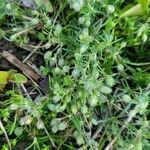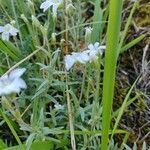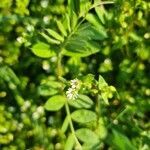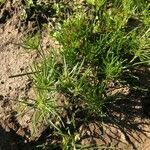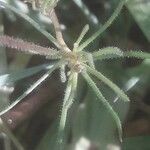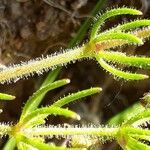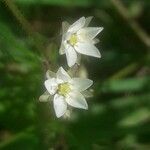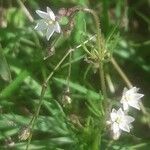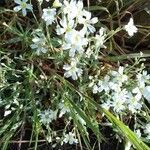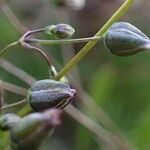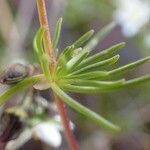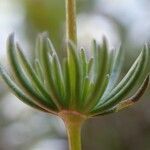Herb, annual with slender to robust tap root, weakly to strongly glandular-pubescent. Stems decumbent to ascending, geniculate, 7–40 cm long. Leaves sessile, narrowly linear, obtuse, fleshy, 10–30 mm long, 0.3–0.8 mm wide, margin strongly revolute so leaves channelled beneath. Stipules small, scarious, often caducous. Inflorescence branching, paniculate; bracts small, scarious. Flowers 4–7 mm diam.; pedicels 4–20 mm long, glandular-puberulent, often strongly deflexed after flowering. Calyx ± glandular-hairy. Sepals ovate, obtuse, 3–5 mm long, with narrow, scarious margins. Petals obovate, obtuse, slightly longer than sepals, white. Capsule ovoid-conical, to twice sepal length, up to 5 mm long. Seeds subglobose or globose, 1–2 mm long, blackish, usually papillose, keeled or very narrowly winged.
Plants annual. Stems (7--)13--50(--60) cm, pilose, apically glandular hairy. Stipules triangular-ovate, small, soon deciduous. Leaf blade linear, (1.1--)1.5--4 cm × 0.5--0.7 mm, abaxially channeled, glabrous or glandular pubescent, apex acute. Cymes lax, at first dichasial, upper branches monochasial. Pedicel 1.5--2.5 cm, slender. Sepals ovate, 3(--5) mm, glandular pub-scent, apex subacute to obtuse. Petals obovate, slightly shorter than to slightly longer than sepals, apex obtuse. Stamens 10, shorter than ovary. Ovary ovoid; style extremely short; stigmas 5. Capsule ovoid, ca. 4 mm in diam., slightly longer than sepals. Seed gray-black, subglobose, slightly compressed, 1--2 mm, both surfaces often with minute, pale, club-shaped papillae, margin with narrow wing. Fl. Jun--Jul, fr. Jul--Aug.
Simple or much-branched annual to 40 cm, sparingly (seldom more copiously) glandular-pubescent; lvs 2–5 cm, narrowly linear or subulate, channelled beneath, clustered at the nodes in two opposite sets of 6–8, appearing verticillate; stipules small but evident; sep ovate, 2–3 mm, obtuse, glandular-puberulent; pet white, obovate, obtuse, shorter to longer than the sep; stamens 10 or sometimes 5; fr broadly ovoid, surpassing the sep; seed 1–1.5 mm, blackish, subglobose, minutely roughened,conspicuously white-papillate and white-margined or narrowly winged; 2n=18. Native of Europe, widespread as a weed in cult. ground and waste places; N.S. to Alas., s. to Fla. and Calif. May–Aug. (S. sativa)
Plants glabrous or, often, glan-dular. Stems usually branched proximally, 10-50+ cm. Leaf blades usually appearing terete, 1.5-3(-5) cm, margins often revolute, forming abaxial channel. Pedicels erect to ascending, reflexed, secund in fruit. Flowers: sepals 3.5-5 mm; petals ovate, 3/ 4-1 times as long as sepals in flower, apex obtuse; stamens usually 10. Capsule valves 3.5-5 mm. Seeds sometimes keeled or winged, subglobose, 1-1.1 mm wide, surface minutely roughened or obscurely low-tuberculate (50×), covered with white, club-shaped papillae in part or throughout (packing of seeds in capsule may prevent papillae development in spots), wings white, ± 0.1 mm wide. 2n = 18, 36 (both Europe).
Very polymorphous annual. Stems up to 50(-70) cm, ± branched from the base, usually glandular hairy in upper part. Leaves linear, 1-4 cm long, apparently whorled, somewhat succulent, furrowed on the lower side. Inflorescences terminal and from the upper leaf axils, ± lax-flowered; pedicels 1.5-2 cm, reflexed after anthesis. Sepals ovate, with scarious margin, 3-5 mm. Petals white, obovate, obtuse, as long as or slightly longer than the sepals. Stamens 10 or 5. Capsule ovoid, up to twice as long as the calyx. Seeds 1-2 mm, greyish, spherical, keeled or with a narrow wing; testa varying in sculpture from almost smooth to papillose.
Annual herb, 0.05-0.30 m high; erect, branches cylindric, glabrous or sparsely glandular-pubescent above. Leaves linear, sparsely glandular-pubescent or glabrescent. Inflorescences few-to many-flowered, pedicellate. Flowers bisexual, subperigynous. Sepals 5, free, herbaceous and often ± fleshy, with scarious margins. Petals 5, entire, white. Stamens 10, arising on a perigynous ring. Ovary 1-locular; ovules many; styles (3-)5, alternating with sepals. Flowering time Aug.-Apr. Fruit a capsule, ± globose, opening by 5 valves or teeth not separating completely. Seeds many, grey-black, compressed, biconvex, very narrowly winged.
Annual herb, (5)-15-30-(60) cm tall. Stems and lvs sparsely to densely covered in glandular hairs. Lvs linear, fleshy, channelled beneath, (5)-10-25-(40) × 0.5 mm; stipules broadly ovate to triangular, scarious, glandular-ciliate, 1-2 mm long. Dichasium lax; peduncle usually = stem internodes; bracts small, scarious. Sepals ovate, glandular, (3)-4-5-(6) mm long; margins scarious. Petals white, c. = sepals. Stamens 5-10. Styles 5. Capsule ovoid, smooth, straw yellow or pale brown, 5-valved, 5-6 mm long, > sepals. Seeds 1 mm diam., biconvex, smooth or papillate, keeled or very narrowly winged, almost black when ripe.
Erect, branched, stems up to 6 dm. or more in height, glabrous below, often glandular-viscid in the upper and inflorescence parts.. Leaves 1–6.5 cm. long, 0.5–0.75 mm. broad, rounded or subacute, channelled on abaxial surface.. Inflorescences 9-many-flowered.. Sepals elliptic, obtuse, 4 mm. long, with white membranous margins.. Petals obovate, 3.75 mm. long.. Capsule with 20–25 seeds.. Seeds biconvex, approximately circular in flat outline, with a narrow but not winged margin, black, with small pale club-shaped papillae.
An annual herb. The plant grows up to 50 cm high. The stems are erect but often bend at the nodes. The leaves are narrow and somewhat fleshy. There is a long furrow on the lower side. This is covered with hairs. The leaves occur in rings. The flowers have fine white petals. The seeds are black and slightly flattened. The seed can stick to the hands when damp.
Erect to suberect annual herb, up to 300 mm tall. Leaves in dense, opposite fascicles, narrowly linear, glandular-pubescent to glabrous. Capsule membranous, splitting into 5 halves. Flowers green and white.
Annual, up to 0.6 m tall, with stems ± branched at base. Leaves apparently whorled, linear, fleshy. Flowers in open, glandular-hairy cymes, petals white, slightly longer than sepals.
Leaves 1–6·5 cm. × 0·5–0·75 mm., linear, rounded or subacute at the apex, channelled on the lower (abaxial) surface, sparsely glandular-pubescent or glabrescent.
Seeds 15–25, c. 0·85 mm. in diam., biconvex, encircled by a very narrow winged margin, from brown to black with paler club-shaped papillae.
Inflorescences few-to many-flowered, branches glandular-pubescent; bracts c. 1 mm. long, ovate, scarious; pedicels up to 2·5 cm. long.
Capsule ovoid or sub-globose, splitting about 2/3 of the way down into 5 valves, exserted for c. 2 mm. from the persistent perianth.
Sepals greenish with a white membranous margin, c. 4 × 2 mm., elliptic, apex obtuse, usually glandular-pubescent outside.
Erect branching herb up to 60 cm. or more tall; branches cylindric, glabrous or sparsely glandular-pubescent above.
Stamens 10, slightly less than half the length of the petals, those alternating with the petals slightly longer.
Annual to 60 cm. Leaves apparently whorled, linear. Flowers in open, glandular-hairy cymes, white.
Petals white, slightly shorter than the sepals, obovate or ovate.
Ovary ellipsoid, very shortly stipitate; ovules fairly numerous.
